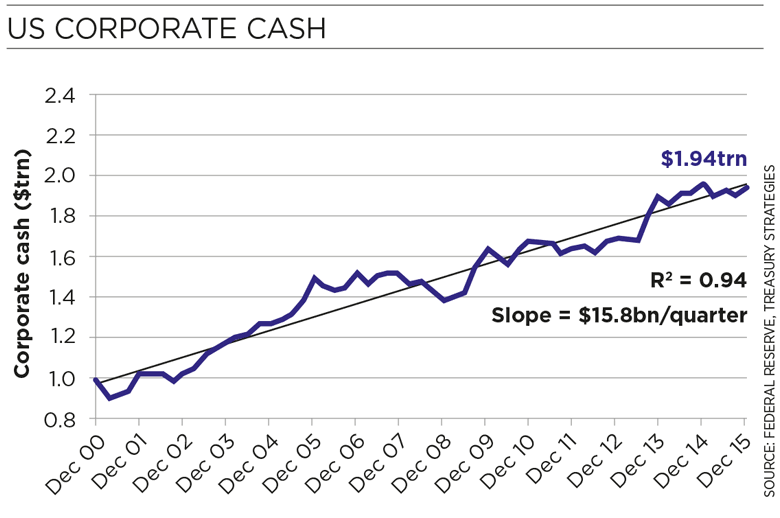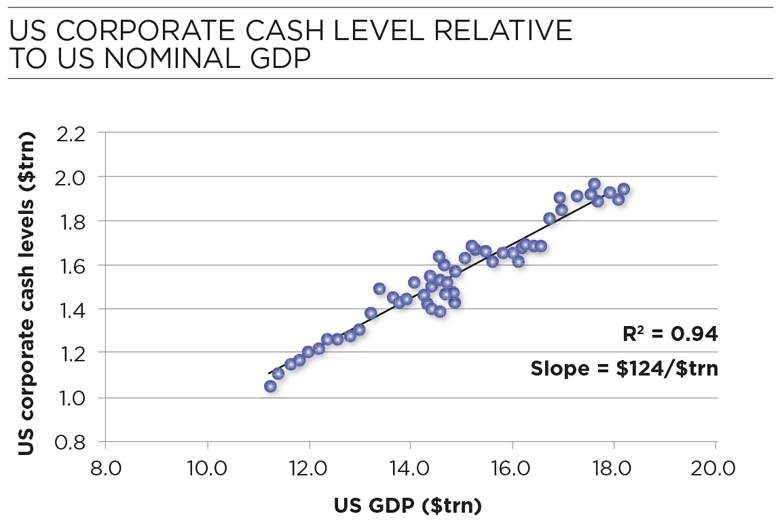
Consider what a great time it is to be a corporate treasurer on this side of the Atlantic.
Low interest rates provide you with a great opportunity to build a solid balance sheet; the European Central Bank is rolling out the red carpet for your bonds, even at zero interest rates; inflation is quiet; there is ample liquidity in the markets; banks are interested in lending; the US dollar is relatively strong and stable; the economy is moving along, albeit in low gear; and technology is enabling and empowering you to expand your remit and create even more value for your company.
Now consider what a challenging time it is to be a corporate treasurer in the US.
Regulations simply remove some of the clear advantages of prime MMFs and place them on par with other MMF instruments and bank deposits
Money market fund (MMF) regulations are narrowing your investment and borrowing options; the Federal Reserve’s $4 trillion balance sheet overwhelms the markets and threatens to blow up even the best strategies on the slightest whim of the governor; regulators, seeing the end of the current US administration, are running their printing presses at full speed, an action certain to create unintended consequences, while Basel III rules are still winding though the banking system with an uncertain, but presumably negative, impact for corporations; the interest-rate picture is not known; and pooling structures are either going away or are priced out of reach.
In this environment, we see our clients, treasurers of large companies, focused on three key areas:
Cash on the US balance sheets of companies doing business there continues to rise. At $1.94 trillion, corporate cash has doubled since the year 2000. At Treasury Strategies, we disagree with pundits and commentators who cite lack of capital spending and a slow economy as the culprit. Rather, we believe that this is a long-term trend in response to uncertainty, concerns about long-term access to credit and a tougher regulatory environment. Treasurers worldwide are simply holding more precautionary cash on their balance sheets.
Fifteen years ago in the US, corporate cash was 9% of GDP. Today, it stands at 11%.

In fact, over that period, for every $1 trillion increase in US GDP, corporate cash increased by $124bn with an astonishing statistical significance of 0.94.
As we work with corporates, we hear the precautionary theme again and again. Will banks restrict credit once the Fed tightens? Will regulation increase the rate at which public-sector credit crowds out the private sector? Will Basel III and the Volcker Rule make underwriting more difficult and costly? Together, these concerns are driving corporate cash accumulation and we don’t see our clients changing that outlook anytime soon.
On 14 October 2016, after a long battle, MMF regulations will go into full effect. Prime institutional funds will be required to float the net asset value (NAV) and their boards will be empowered to institute liquidity fees and redemption gates.
These regulations have led to steady outflows since the first proposals in 2010. Assets have fallen from $1.7 trillion to $1.2 trillion, mostly flowing into government MMFs. There is speculation that the decline will continue as the effective date approaches. In preparation, many fund managers are shortening their maturities. Some managers are investing very little with maturities beyond October 2016.
Several problems flow from this:
Some treasurers feel that the combination of a floating NAV, liquidity fees and redemption gates render prime MMFs a less effective instrument and possibly at odds with the company’s investment policies. We have the contrary view that the regulations simply remove some of the clear advantages of prime MMFs and place them on par with other MMF instruments and bank deposits. Consider the three key planks:
Treasurers are gradually becoming aware that, from the standpoint of investor utility, prime institutional funds are still the most attractive instrument.
We believe that, although assets will continue to decline as we approach the October go-live date, they will rebound quickly and remain the instrument of choice for US treasurers.
Over the past several years, companies have been very busy upgrading their treasury management systems. For most, this meant replacing older treasury workstations or upgrading to newer versions. As these systems grew in power and functionality, many companies underestimated the complexity of the implementations. They became the platform for efficient liquidity management.
The upshot was that many companies implemented the basics while the more advanced features were postponed until Phase II. Although the core cash management processes were automated and the new technology added value, there remained numerous Excel or other external workarounds.

Many corporate treasuries are embarking on Phase II this year. Companies are implementing modules that had been purchased, but unused. Investment tracking, FX, debt management, cash forecasting and risk management generally top the list. They are improving connectivity with all of their banks, not just a few. They are implementing comprehensive bank account management tools as well. This is a tall order and will keep companies busy well beyond 2016.
Challenges for US corporate treasurers abound. The market has given a temporary reprieve in the form of low rates and a relatively strong dollar. Wise treasurers are taking advantage of this environment to upgrade their treasury systems, improve their business processes and strengthen their balance sheets.
Anthony J Carfang is a partner with US consultancy Treasury Strategies
